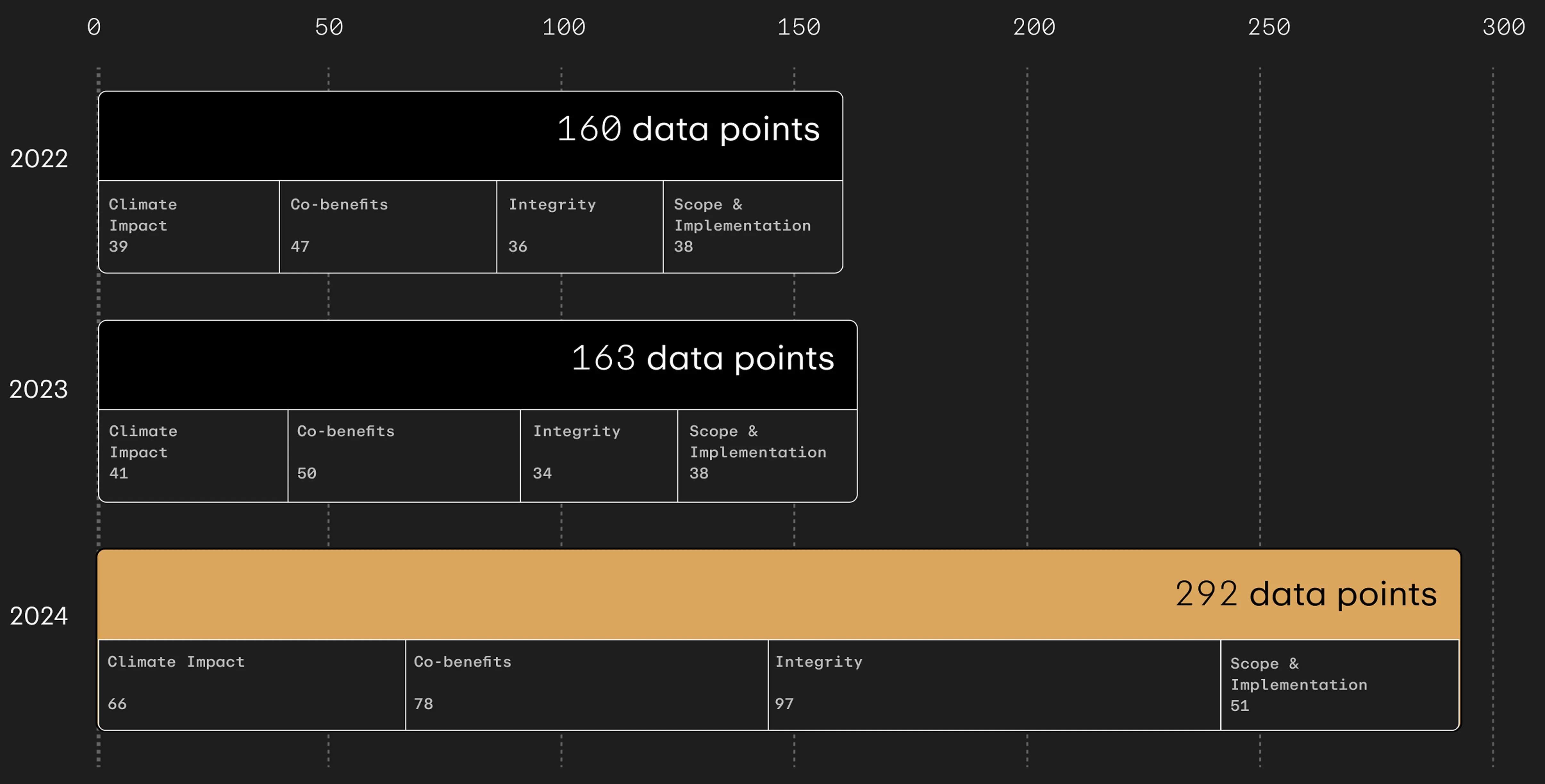
The science-led, tech-enabled carbon removal approach for forward-thinking companies.
Carbon removal is the biggest real-world industry to emerge in the 21st century. We are guided by science and leverage tech to enable growth and solve physical problems at scale.
Best in class carbon removal.
Our proprietary knowledge of the latest science and stringent project selection allow you to navigate this ever-evolving industry with confidence.
Since our inception, we’ve gone beyond just aligning with the leading scientific voices in the field, exceeding industry norms and expectations, and have always invested solely in removals.
Minimised risk in investment with better data collection and tailored due diligence.
Increased minimum standards to ensure impact and continually ‘raise the bar’.
Remain ahead of the regulatory curve and industry gaps, building market of the future.
We’ve compared our process to the leading buyers and organisations:




Benchmarking with the best:
Our industry-leading due diligence framework ensures you to stay ahead of the curve and align with science.
We work with only the best projects rather than prioritising quantity. By continually increasing our minimum standards, we set a higher expectations for projects to rise to. This allows us to know the projects inside-out and better match projects with clients wants and needs.
Now, with 292 data points, we are able to stay ahead of market challenges and continue raising the bar.
The data collection process is no easy task–but we’re committed to continually raise minimum quality and integrity standards for the market as a whole.

Climate impact
Klimate evaluates the permanence, rapidity, additionality, and effectiveness of carbon removal projects to determine the impact they have on climate change.
A carbon removal project is deemed additional if it creates an impact that would not have otherwise occurred in the absence of the project implementation. Additionality ensures that CDR takes place on top of emissions reductions, so that current emission scenarios cannot continue.
This category looks into the project’s operational emissions and the intensity ratio of resources needed by the carbon removal project as life cycle analyses. This ratio should be as low as possible.
Carbon removal projects combat climate change by removing atmospheric CO₂ , storing it in reservoirs, and preventing it from being re-emitted. The more permanent a removal is, and the lower the risk of reversal, the longer it keeps carbon locked away in reservoirs. Furthermore, different methods sequester carbon over a range of timescales. Rapidity measures how quickly carbon can be stored, which is crucial as climate change amplifies global warming over time.
Co-benefits
To address potential issues with carbon tunnel vision, we go beyond by evaluating the social and environmental benefits these projects generate, such as native biodiversity, soil health, or community well-being.
There are many synergies between projects and many aspects of the environment, such as, biodiversity, ecosystem habitat, resource quality, and climate resilience. However, strong protections against environmental harms are essential for a high-quality project to consider.
Beyond carbon, socially positive impacts can can include job creation, increased welfare, or capacity building for community well-being. However, there are social harms such as displacement that must safeguarded against.
Acknowledging that climate change needs to be addressed beyond carbon removal, the projects are assessed by its contribution and synergies towards the Sustainable Development goals.
Integrity
Klimate analyses the carbon accounting, certification standards, and verification procedures of carbon removal projects to ensure they are sound and credible. We hold projects to these high standards to help drive the overall integrity of the market.
Different national and international standards exist across methodologies beyond our own and those conducted internally by projects. These bodies have well-defined processes which verify and audit projects for its traceability, methodologies, and compliance. Thus, adding another important layer of checks and balances.
Different types of projects and technologies have different ways of issuing, delivering, and contracting credits. These various differences are also often reflected in the credit’s price. For example, ex-ante credits are based on a predicted future removal and involve higher risk, while ex-post credits are based on verified removals that have already occurred.
This is the continual measurement of progress towards the project’s benefits. This includes the carbon being removed, associated co-benefits, and the project’s impact on the environment. It ensures the quality of integrity associated with the impact of investment.
Scope and Implementation
We analyse the potential benefits and risks of the carbon removal projects and technologies to future-proof your investments.
Critical to our common climate goals is scaling carbon removal. Thus, it is important to analyse the scale and scope, as well as a project’s ability and limits to growth.
Knowing the project’s risks and its associated mitigation measures that could affect its operations is vital to ensuring the safety and reliability of the carbon storage.
Ensuring best practice across the carbon removal market is essential to reaching our future climate goals. We analyse these governance structures, such as procedures, policies, and local community engagement.
Get to know the science that shapes our business.
Our approach is guided by leading authorities and scientific experts to ensure investment in high quality, high integrity, and additional carbon removal projects. This is the path to a net zero future.
"Our partnership with Klimate has been instrumental in simplifying our CSRD reporting process. Their platform not only saved us countless hours of work but also made auditor access as simple as sharing a link—I only wish all aspects of CSRD data collection were this seamless."
We build, so you can evolve.
Our experts are here as your guide.
We’re ambitious experts ready to analyse and advise on the leading projects in the carbon removal space. We work together to source the right solutions for you. No matter where you are on your sustainability journey, our team is here to help.
.webp)
Yasmine Rocco
Carbon Removal Specialist
Yasmine specialises in developing carbon removal strategies and forging partnerships to enable a low carbon economy. She has an MA in Innovation and Sustainable Development from Lund University.
.webp)
Tim Nicol
Carbon Removal Specialist
Tim holds an MSc in Climate Change from the University of Copenhagen and a BSc in Earth Sciences. He has 3 years' experience in CDR and has previously worked in wind energy and environmental impact at two Danish startups.
.webp)
Simon Bager
COO & Co-Founder
Simon holds a PhD in Science and has a decade of experience advising top corporates and public organizations on energy, climate, and sustainability, with deep knowledge of carbon removal and practical project implementation.

Lauren Brown
Head of Carbon Removal
Lauren has a background in sustainability across the energy, rail and construction sectors. Her expertise includes carbon measurement, LCAs and environmental engagement.

Matt Averna
Head of Impact Strategy
Matt focuses on connecting Klimate’s Impact and Growth teams in order to drive maximum climate and client impact. He has previous experience in carbon markets, small farmer adaptation finance and impact program management.

Erik Wihlborg
Chief Commercial Officer
Erik leads Klimate’s commercial team and is an expert in developing carbon removal strategies that align with client’s requirements and needs.
Talk to a carbon removal specialist.
Finding the right way to remove your CO₂ emissions can seem overwhelming.
Our team is here to help.







.svg)

